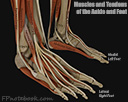II. Epidemiology
- Posterior Tibialis Tendinopathy is found in up to 16% of all ankle injuries
- Gender predominance in women (esp. if Overweight)
- Typically over age 40 years
- Nontraumatic mechanism affects age >65 years globally
III. Physiology
IV. Risk Factors
- Decreased ankle perfusion
- Obesity
- Diabetes Mellitus
- Hypertension
- Collagen vascular disease
- Corticosteroid use
- Overuse
- Excessive foot pronation (over-pronator)
V. Causes
- Acute posterior tibial Tendon Injury
- Twisting foot
- Stepping in hole
- Slipping from curb
- Chronic posterior tibial Tendon Injury
- Typically, no recollection of acute injury
- Medial longitudinal arch collapse
- Associated with overuse or poor gait mechanics
VI. Symptoms
- Years of pregressive pain along the lateral tarsal region
VII. Signs
- Observation
- Flat foot deformity (pes planovalgus deformity)
- Hindfoot valgus deformity
- Too Many Toes Sign (when viewing ankle and foot from behind)
- Only the 5th toe and one half of the fourth toe should be visible
- Positive test when the third toe is visible (not hidden by the lateral malleolus)
- Palpation
- Pain and swelling posterior to medial malleolus over posterior tibial tendon
- Tendon insertion is on the navicular tuberosity
- Provocative factors
- Weight bearing
- Pain or weakness on resisted inversion of the foot when plantar flexed
- Medial ankle instability (severe cases where the deltoid ligament is stretched)
- Specific testing
- Heel varus is absent when standing on tiptoe
- Pain with single-leg toe raise and unable to complete 10
- Weakness on single leg heel raise
- Plantar flexion ability lost (peroneal tendon rupture)
VIII. Evaluation: Stages of Posterior Tibial Tendinopathy (Johnson and Strom Classification)
- Stage 1
- Pain and swelling of posterior tibial tendon (posteromedial ankle) radiating to arch of foot
- No foot deformity
- Patient can perform single-leg heel raise
- Stage 2
- Pain and swelling of posterior tibial tendon, worse with weight bearing
- Patient cannot perform single-leg heel raise
- Flexible subtalar joint
- Pes Planus and loss of medial longitudinal arch
- Midfoot adduction
- Stage 3
- Stage 2 tenderness at posterior tibial tendon has increased, but swelling has decreased
- Posterior tibial tendon disrupted with multiple tears on imaging
- Subtalar joint is fixed
- Ankle Arthritis
IX. Differential Diagnosis
- Medial Ankle Sprain (most common misdiagnosis)
- Flexor digitorum longus Tendinopathy
- Flexor Hallucis Longus Tendinopathy
- Tarsal Navicular Stress Fracture
- Tarsal Tunnel Syndrome
X. Imaging
-
Foot
XRay
- Loss of medial arch (may also be seen with weight bearing exam)
- Test Sensitivity: 71%
- Test Specificity: 89%
-
Ankle Ultrasound
- Test Sensitivity: 80%
- Test Specificity: 90%
-
Ankle MRI
- Test Sensitivity: 95%
- Test Specificity: 100%
- References
XI. Management
- Acute Management
- RICE-M
- NSAIDs
- Shoe Orthotic (decrease foot pronation and support arch)
- Medial longitudinal arch support taping
- Posterior tibial tendon Stretching and strengthening (Eccentric Exercises)
- Patient sits with affected leg crossed over the unaffected leg
- Resistance Band (e.g. Theraband) wrapped around affected midfoot
- Stabilize band under the planted unaffected foot on floor
- Patient passively inverts their foot and ankle against band resistance
- Then gradually relax and repeat
- Immobilization (e.g. CAM Walker boot) for 2-3 weeks
- Consider in severe cases
- Avoid Corticosteroid Injection (risk of posterior tibial tendon rupture)
- Orthopedic referral indications
- Failed conservative therapy above
- Consider for severe refractory stage 1 Tendinopathy
- Consider for Debridement with or without tenosynovectomy
- Consider for stage 2 Tendinopathy
- Consider for surgical management (e.g. flexor digitorum longus transfer)
- Stage 3 foot deformity
- Arthrodesis (subtalar or triple fusion)
XII. Complications: Occur more often in the absence of treatment
-
Foot deformity (painful Flatfoot)
- See Rigid Flatfoot
- Posterior tibial tendon rupture

